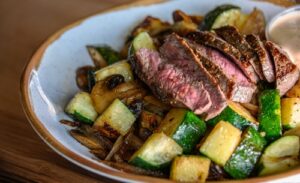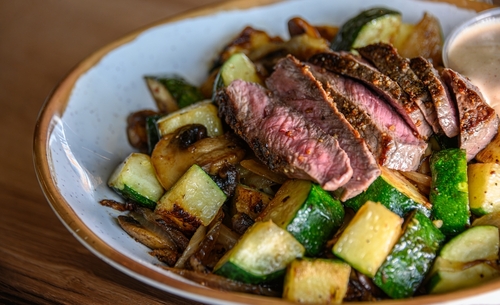When it comes to flavorful grilled meals, two powerhouse cooking styles dominate the conversation: BBQ and hibachi. Each offers a unique approach to fire, flavor, and dining experience. Understanding the difference between BBQ and hibachi goes beyond cooking methods—it’s about culture, ingredients, and how people come together around food.
From smoky Southern brisket to sizzling teppanyaki-style shrimp, BBQ and hibachi bring different traditions to the table. Let’s dive into what makes each one special, how they compare, and where you can enjoy authentic hibachi in Miami.
What Is Hibachi?
Traditional Japanese Origins of Hibachi Cooking
The term “hibachi” comes from the Japanese word for “fire bowl” (火鉢), referring to a small, open-top container once used to burn charcoal for heat. Originally, hibachi was a form of indoor heating rather than cooking. However, over time, the term evolved to describe small grills used to cook food over charcoal in traditional Japanese households.
In its early culinary use, hibachi grilling was straightforward—simple meats, vegetables, and seafood were cooked directly over hot coals. It emphasized clean, natural flavors and precise heat control, often served as part of home-style meals or outdoor gatherings.
The Modern American Hibachi Experience (Tabletop Grilling + Entertainment)
In the United States, “hibachi” often refers to teppanyaki-style cooking—where chefs prepare meals on a large, flat iron griddle directly in front of diners. While technically distinct (hibachi = open-grill, teppanyaki = flat griddle), the American hibachi restaurant blends the two concepts for a one-of-a-kind dining show.
At places like Yume Ramen & Hibachi in Miami, guests enjoy more than just food—they experience culinary theater. Flames rise, utensils fly, and chefs interact with the audience while preparing steak, shrimp, rice, and vegetables with dramatic flair. It’s part meal, part performance, and wholly memorable.
Common Ingredients and Cooking Style Used in Hibachi
Hibachi cooking relies on a flat griddle surface, high heat, and minimal oil to quickly sear proteins and veggies. Common dishes include:
- Thinly sliced steak, chicken, or shrimp
- Fried rice or noodles
- Zucchini, onions, mushrooms, and carrots
- Garlic butter, soy sauce, and light seasonings
The emphasis is on freshness, fast cooking, and ingredients that shine without heavy sauces or smoke. Meals are typically served with dipping sauces like ginger, mustard, or teriyaki.

What Is BBQ?
Definition and Global Variations of Barbecue
“Barbecue” is both a cooking method and a cultural staple. It involves slow-cooking meat over low heat—typically using wood smoke—for long periods. Barbecue traditions exist around the world, from Argentina’s asado to Korean galbi, but in the U.S., it’s most famously associated with Southern states like Texas, North Carolina, and Tennessee.
Depending on the region, “BBQ” may involve smoking, grilling, or roasting meats with various techniques and flavor profiles. It’s as much about social gatherings as it is about food—often enjoyed at backyard cookouts, food trucks, and smokehouses.
Low-and-Slow Cooking vs. Open-Grill Styles
The hallmark of American BBQ is “low and slow.” Meats like brisket, pulled pork, and ribs are cooked at low temperatures (around 225–275°F) for several hours using indirect heat and flavored wood smoke.
In contrast, other styles of barbecue—like Caribbean jerk or Brazilian churrasco—use open flames and shorter cook times, but always with strong marinades or rubs to pack in flavor.
Common Meats, Rubs, Sauces, and Smoking Techniques
BBQ menus often showcase:
- Beef brisket, pork ribs, chicken, sausages
- Dry rubs with paprika, brown sugar, chili powder, garlic, and pepper
- Signature regional sauces: vinegar-based, tomato-based, mustard-based, or white Alabama-style
- Wood chips for smoke (hickory, mesquite, oak, applewood)
The result is tender, richly seasoned meat with layers of smoke, spice, and sweetness.
Key Differences Between BBQ and Hibachi
Cooking Methods: Smoke vs. High-Heat Griddle
BBQ uses indirect heat and smoke to break down tough cuts of meat over hours, developing deep flavor. Hibachi, on the other hand, uses direct, high-heat searing on a flat iron griddle, emphasizing speed, texture, and freshness.
BBQ is slow and methodical. Hibachi is fast and interactive.
Flavors and Seasonings: Bold Sauces vs. Simple Teriyaki/Garlic Butter
Barbecue is all about bold, often spicy or smoky flavors. Sauces, marinades, and rubs take center stage. Hibachi leans toward lighter seasoning—soy sauce, sesame oil, garlic, and ginger are used sparingly to enhance the natural taste of each ingredient.
While BBQ delivers a rich, heavy bite, hibachi provides a clean and umami-packed experience.
Cultural and Dining Experience Differences
BBQ often revolves around outdoor get-togethers—picnics, festivals, and cookouts. It’s informal and communal, with food prepared in bulk and served buffet-style or from a smoker.
Hibachi is more theatrical and personal. Meals are made to order by a chef at your table, offering a dining show and interaction. It’s great for birthdays, date nights, and family gatherings where entertainment is part of the value.
Which One Should You Choose? Hibachi vs. BBQ for Your Next Meal
Flavor Preferences and Dietary Needs
If you enjoy smoky, spicy, and indulgent meats—BBQ will hit the spot. It’s ideal for meat lovers who crave richness and depth of flavor. Hibachi is better suited for those who prefer lighter meals with fresh vegetables, lean proteins, and minimal grease.
Hibachi is also a great choice for pescatarians and those avoiding heavy sauces or fried foods.
Casual Backyard Vibes vs. Interactive Dining Show
BBQ sets the mood for relaxed afternoons, often paired with beer, live music, and sunshine. It’s about enjoying the moment with friends and neighbors. Hibachi offers a more refined yet entertaining experience—perfect for special occasions where food becomes a performance.
Lighter, Faster Meals vs. Hearty, Slow-Cooked Plates
Need a quick, satisfying meal without the food coma? Hibachi is your answer. The cooking is fast, and portions are often balanced. If you’re ready to indulge in a slow-cooked feast with leftovers guaranteed—BBQ wins.
Try Authentic Hibachi in Miami at Yume Ramen & Hibachi
Our Teppanyaki-Style Hibachi Dishes
At Yume Ramen & Hibachi, we serve up classic hibachi meals with premium ingredients and a modern twist. From filet mignon and scallops to tofu and mixed vegetables, each dish is cooked fresh on a sizzling hot plate by a skilled chef right at your table.
Chef Performances and Family-Friendly Atmosphere
It’s more than dinner—it’s a show. Our chefs flip shrimp into hats, create onion volcanoes, and keep guests laughing while preparing your meal. Whether it’s date night or a birthday celebration, our hibachi tables bring people together in a fun and flavorful way.
Fresh Ingredients, Cooked Right in Front of You
We take pride in using high-quality proteins, locally sourced produce, and traditional Japanese flavors. Every meal is made-to-order and packed with freshness. Come taste the difference at Yume—Miami’s go-to spot for hibachi done right.

FAQs – BBQ vs. Hibachi
Is Hibachi Healthier Than BBQ?
Hibachi cooking is often considered healthier due to its use of lean proteins, fresh vegetables, and minimal oil. The high-heat griddle method retains nutrients and avoids heavy sauces or smoke. In contrast, BBQ often includes fatty cuts, sugary rubs, and prolonged smoking, which can increase calorie and sodium content.
Can You Grill BBQ on a Hibachi?
Technically, you can cook barbecue-style meats on a hibachi grill, especially if using a charcoal version. However, traditional BBQ requires low, indirect heat and extended cooking time for tenderness and flavor. Hibachi grills are better suited for quick-searing thin cuts, not for smoking or slow-cooking larger meats like brisket or ribs.
What’s the Difference Between Hibachi and Teppanyaki?
Hibachi refers to a small, open-grate charcoal grill, traditionally used in Japan. Teppanyaki involves cooking on a large, flat iron griddle. In the U.S., “hibachi” is often used interchangeably with teppanyaki, but true hibachi is grill-based, while teppanyaki offers tableside cooking with theatrical chef performances and a flat cooktop.
Do You Need Special Equipment for Hibachi Cooking?
You do need special equipment to cook hibachi-style meals properly. A flat iron griddle or a traditional open-top grill is essential for achieving the high-heat sear and fast cooking hibachi is known for. Additional tools like long spatulas, squeeze bottles, and proper ventilation enhance safety and performance.
BBQ and Hibachi Are Both Delicious — Here’s Why We Love Hibachi
When comparing the difference between BBQ and hibachi, the real takeaway is that both offer something special. BBQ is bold, smoky, and comforting. Hibachi is fresh, fast, and fun.
But at Yume Hibachi, we believe in elevating the meal into a memory. With chef-led cooking shows, quality ingredients, and a family-friendly vibe, hibachi isn’t just a meal—it’s an experience.
Whether you’re craving teriyaki steak or crispy fried rice cooked before your eyes, we invite you to discover the interactive magic of hibachi. Book your table in Miami today and savour the difference. Contact Us Now!

